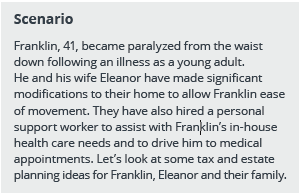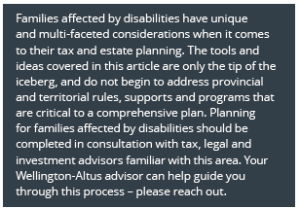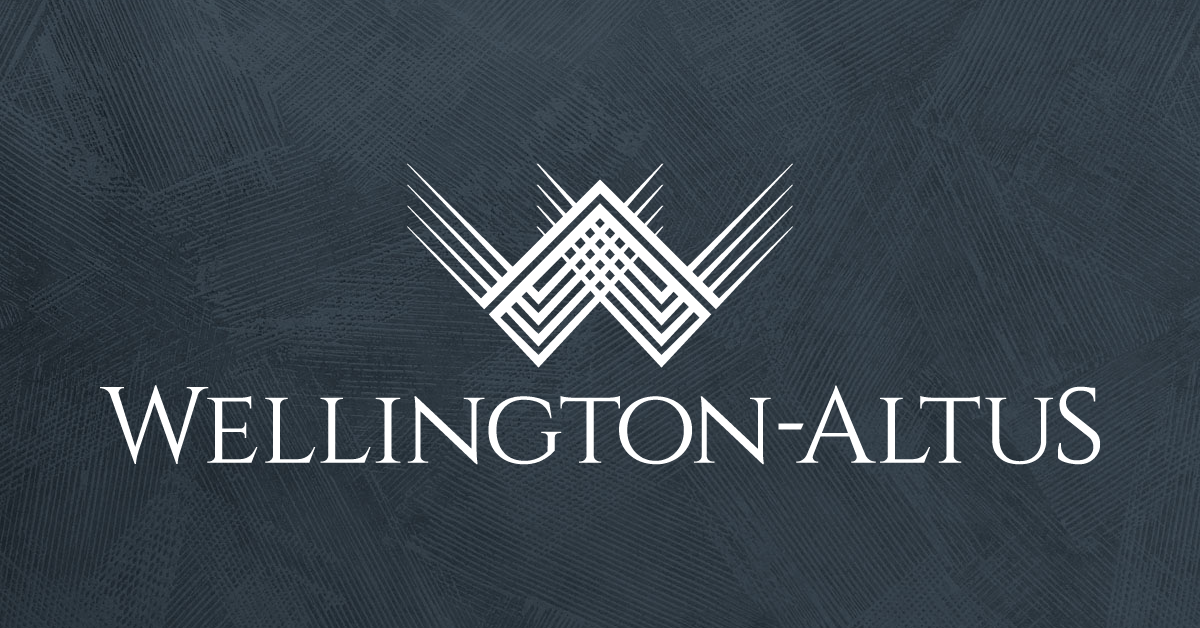More than one-fifth of Canadians over the age of 18 are living with disabilities,1 often with special needs
which can entail significant costs. There is a vast network of supports, programs and tax rules designed to assist Canadians and ease the financial burden that can sometimes accompany a disability, but the opportunities available and how to access them are not always obvious. While not exhaustive, this article
highlights a few federal programs that families affected by disabilities may find useful.

Disability Tax Credit (DTC)
Franklin’s first step should be to apply for the DTC. This tax credit provides tax relief for qualifying individuals, and more importantly, opens the door to a plethora of other benefits.
- What is it? A non-refundable personal federal tax credit of up to approximately $1,414 for 2023 (or up to $2,239 if under 18 years old), with an additional provincial or territorial amount based on residence.
- Who is eligible? Individuals with a severe and prolonged impairment in one or more activities of
daily living, i.e. speaking, hearing, walking, feeding, dressing, bowel/bladder elimination, and mental
functions for everyday life. Where the cumulative effect of two or more impairments leads to a
marked restriction in the ability to perform such activities, the individual may qualify for the DTC.

- What are the benefits? Aside from the tax credit itself, DTC eligibility provides access to a Registered Disability Savings Plan, credits and deductions relating to education, attendant care, childcare and disability supplements, and tax-preferred treatment for certain trusts and their beneficiaries, to name a few.
If his DTC application is approved by the Canada Revenue Agency, Franklin can claim renovation expenses on his tax return for eligible costs incurred to make his home more accessible. He may also be able to claim medical expenses for the wages paid to his personal support worker, however this may limit his ability to claim the DTC amount.

Registered Disability Savings Plans (RDSP)
Once Franklin qualifies for the DTC, he can open an RDSP.
- What is it? An RDSP is a tax-sheltered savings vehicle designed to help families ensure the long-term financial security of a loved one affected by a disability.
- Who is eligible? Canadian residents under the age of 60 with a valid social insurance number (SIN) and who qualify for the DTC can be beneficiaries of an RDSP.
- What are the benefits? Allows for tax-sheltered growth on up to $200,000 of contributions. Contributions can attract the Canada Disability Savings Grant and Canada Disability Savings Bonds (income dependent), along with other grants and bonds.
Investment income earned in an RDSP will not be taxed until it is withdrawn. While Franklin will have to begin withdrawing from his RDSP by the end of the year in which he turns 60, he still has almost two decades to defer taxation on that income using his RDSP. Also, RDSPs are generally excluded from a person’s assets for purposes of determining eligibility for provincial disability supports. As a result, Franklin should be able to accumulate wealth in his RDSP without impacting his access to provincial benefits.
Henson Trust
Depending upon the province, a person’s assets, means or a combination of both are used as thresholds
to access disability supports. If Franklin and Eleanor are concerned that their assets or income will be too high for Franklin to continue to receive such supports, they may
consider whether a Henson trust is appropriate for them.
chevron-right
- What is it? A Henson trust gives the trustees complete discretion as to whether, when and how much to pay out to beneficiaries. Generally, the primary beneficiary is an individual receiving disability supports.
- Who is eligible? Anyone can set up a Henson trust in their lifetime or will. As requirements vary between provincial jurisdictions, it is important to consult a trusts lawyer to ensure proper set-up of the trust.
- What are the benefits? Depending on the jurisdiction, assets in a Henson trust are not generally considered to be assets of the beneficiary and do not impact access to provincial supports. The Henson trust can also be a powerful estate planning tool where capacity of the primary beneficiary is in question. The trust terms can effectively bypass the beneficiary’s estate by providing for secondary beneficiaries of the trust assets once the primary beneficiary passes away.

It is a good idea for families to revisit their wills and estate plans when a family member is affected by
a disability. Franklin’s parents are in the process of updating their wills. Estate planning tools that can help transfer wealth to an heir with a disability, like Franklin, include:
- Qualified Disability Trust (QDT). A QDT is a testamentary trust for a beneficiary who is eligible
for the DTC. Contrary to most trusts, income in the QDT is taxed at graduated rates if an annual
election is made. - Preferred Beneficiary Election (PBE): Certain trusts can make an election to have the trust
income taxed in the hands of a DTC-eligible beneficiary2 at their marginal tax rates. While the
election allows for a favourable tax treatment, the trust income is not paid out and generally
does not impact provincial supports for the preferred beneficiary. PBE’s are available both for
testamentary and inter vivos trusts. - Rollover of RRSP/RRIF to an RDSP: The RRSP or RRIF of a deceased individual can be rolled (i.e., transferred without immediate tax implication) to the RDSP of a child or grandchild who was financially dependent on the deceased because of physical or mental infirmity. Total contributions and transfers to an RDSP are subject to the $200,000 limit.


